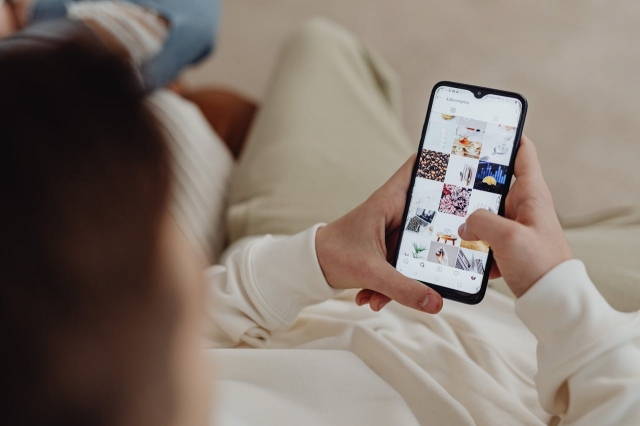In today’s digital age, visuals have become the core of online interaction. Statista said more than 3.6 billion people worldwide used social media in 2020. It is forecasted to be nearly 5 billion by 2025. Moreover, a Smart Insights report shows that over 90% of all online content shared today is visual, with photos being the most engaging format. This explosive growth highlights how people prefer to connect quickly and emotionally through images rather than text alone. At the heart of this trend is instant photo sharing, which allows users to capture, upload, and share moments in real time.
This shift is more than a convenience—it transforms how people communicate, build relationships, market businesses, and even define culture. Let’s explore why instant photo sharing reshapes how we connect online.
The Rise of Instant Photo Sharing
Two decades ago, sharing photos instantly wasn’t possible. People used to rely on film cameras, waiting days for prints before showing them to friends and family. Digital cameras sped things up, but the real revolution began with smartphones. Platforms like Instagram, Snapchat, and Facebook Messenger made it possible to capture a moment and share it across the globe in seconds.
Today, this instant capability has become a social expectation. If something exciting happens—a birthday, a concert, or even a casual dinner—people quickly pull out their phones, snap a picture, and share it instantly. The trend is clear: the faster we share, the closer we feel to our online communities.
How Instant Photo Sharing Shapes Communication
Instant photo sharing has redefined communication. Instead of typing long paragraphs, people now send images to convey emotions or experiences. A picture of a coffee cup can mean “thinking of you,” while a travel selfie can instantly update loved ones about your adventures.
This visual-first communication makes interactions more authentic and engaging. It bridges gaps when words aren’t enough, especially across languages and cultures. Photos often act as digital “shortcuts” to storytelling, delivering more impact in a fraction of the time.
Moreover, using ephemeral content—temporary photos or “stories” on platforms like Snapchat, Instagram, and WhatsApp—has added a new layer of intimacy. Because the content disappears, it encourages users to share more casual, real-time updates, creating a stronger sense of presence and immediacy.
Impact on Personal Relationships
Instant photo sharing strengthens personal relationships by enabling people to stay connected regardless of distance. Families scattered across different cities or countries can share everyday moments—like a child’s first steps or a home-cooked meal—in real time. Friends can celebrate milestones together even when miles apart.
A Pew Research study found that 81% of adults believe photo and video sharing strengthens their relationships with friends and family. It shows how powerful visuals are in maintaining emotional closeness.
Conversely, the constant stream of photos can fuel comparison and “fear of missing out” (FOMO). Seeing others’ curated experiences may create pressure to share equally exciting content. Despite these challenges, the ability to instantly share personal visuals remains a vital tool for nurturing connections.
Role in Business and Marketing
Instant photo sharing is shaping personal lives—it’s transforming business and marketing strategies. In fact, according to Social Media Today, 71% of consumers are more likely to purchase a product if it is suggested through social media visuals.
Brands use instant photo sharing to:
- Promote products with authentic, user-generated content
- Build trust by showcasing behind-the-scenes moments
- Engage audiences with real-time campaigns and contests
- Humanize their brand through visual storytelling
For example, restaurants instantly encourage customers to share food photos, creating free word-of-mouth marketing. Retail brands rely on influencers who post “unboxing” content when products arrive. The speed of sharing spreads brand visibility and creates a sense of urgency among potential buyers.
Instant photo sharing has become a cornerstone of influencer marketing, where credibility and real-time authenticity are highly valued. Businesses that fail to adapt to this trend risk losing relevance in an image-driven world.
Psychological and Cultural Shifts
Instant photo sharing has also brought about profound psychological and cultural changes. On a personal level, capturing and sharing images fulfills a human need for recognition and validation. Every “like” or comment acts as social proof, reinforcing one’s sense of belonging.
Culturally, photo sharing is influencing global viewpoints. People are into various lifestyles, traditions, and events worldwide in real time. This exposure fosters understanding and cross-cultural dialogue but can also blur the lines between reality and digital representation.
Interestingly, studies show that people remember visuals 65% better than text after three days. It proves why instant photo sharing has become a powerful tool for individuals and organizations to make lasting impressions.
Challenges and Privacy Concerns
Despite its benefits, instant photo sharing raises significant concerns. Privacy is at the forefront. Once a photo is shared, when control over the circulation of something is compromised, it can lead to a loss of oversight. Sensitive images can be misused, raising risks of identity theft, cyberbullying, or reputational harm.
Another challenge is the pressure to overshare. The ease of uploading creates a digital culture where people sometimes prioritize capturing the moment over living it. Constant documentation may also lead to stress and burnout, particularly for influencers and businesses that rely on continuous engagement.
Platforms are introducing better privacy controls, encryption, and time-limited sharing features to address these concerns. Still, users must remain cautious and mindful of what they share online.
The Future of Instant Photo Sharing
Looking ahead, instant photo sharing will only become more immersive. Advancements in augmented reality (AR) and artificial intelligence (AI) are already enhancing how people capture and share photos. Filters, AI-driven editing tools, and real-time enhancements make shared content more creative and polished.
Additionally, as 5G technology expands globally, uploading and sharing high-resolution photos and videos will become even faster, reinforcing the demand for instant sharing.
We can also expect instant photo sharing to merge with other technologies, such as virtual reality, creating experiences where people don’t just see a photo but feel like they’re living the moment alongside the sharer. This evolution will continue to redefine online connections and human interaction.
Conclusion
Instant photo sharing has moved beyond digital convenience—it has become a powerful force shaping how we connect, communicate, and experience the world. From personal relationships to global business strategies, its influence is undeniable.
By enabling people to share memories instantly, instant photo sharing fosters closeness, builds trust, and creates cultural bridges. Yet, it also raises challenges around privacy, mental health, and digital balance. As technology evolves, instant photo sharing will remain central to online interaction, making the world feel smaller and more connected.
For individuals, the key lies in sharing responsibly. For businesses, the opportunity is to harness visual storytelling to build stronger relationships with audiences. In either case, one thing is sure: instant photo sharing isn’t just changing how we connect online—it’s redefining connection itself.






